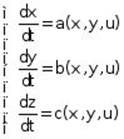University Mathematics Handbook (2015)
XIV. Partial Differential Equations (PDE)
Chapter 3. Quasi-Linear PDE
![]() (*)
(*)
when ![]() ,
, ![]() ,
, ![]() are of class
are of class ![]() (see VII.4.3).
(see VII.4.3).
Solution ![]() or
or ![]() written in its implicit form is called an integral surface.
written in its implicit form is called an integral surface.
3.1 General Solution
a. Surface ![]() is an integral surface of (*) if, and only if, in every point
is an integral surface of (*) if, and only if, in every point ![]() on
on ![]() , there holds
, there holds
![]()
b. An integral surface consists of characteristic curves
![]()
Therefore, vectors ![]() and
and ![]() are parallel.
are parallel.
c. To find out all characteristic curves, we solve characteristic equation system
![]() or
or  (**)
(**)
d. Theorem: If a general solution of (**) is given as the intersection of the two surfaces ![]() and
and ![]() , then for every continuous function
, then for every continuous function ![]() with partial continuous derivatives, the surface
with partial continuous derivatives, the surface
![]()
is an integral surface of (*), for every arbitrary choice of parameters ![]() .
.
3.2 Cauchy Problem
a. Finding integral surface ![]() of PDE (*), passing through characteristic curve
of PDE (*), passing through characteristic curve ![]() is a Cauchy problem.
is a Cauchy problem.
b. Existence and Uniqueness Theorem: If, in PDE (*)
1. ![]() in solid
in solid ![]() .
.
2. ![]() is a smooth, simple curve (see XII. 1.4).
is a smooth, simple curve (see XII. 1.4).
3. There holds the transversality criterion
![]()
That is, if vectors ![]() and
and ![]() are not parallel, then there exists a unique integral surface
are not parallel, then there exists a unique integral surface ![]() containing
containing ![]() .
.
c. If the transversality criterion of b. does not hold, then, when the rank of matrix
![]()
is ![]() , the Cauchy problem has an infinite number of solutions. When
, the Cauchy problem has an infinite number of solutions. When ![]() , the Cauchy problem has no solutions.
, the Cauchy problem has no solutions.
d. Lagrange's Method of Solution:
If the general solution of characteristic equation (**) is the line of intersection between surfaces ![]() and
and ![]() , and initial condition
, and initial condition ![]() is also given as the intersection of surfaces
is also given as the intersection of surfaces ![]() ,
, ![]() , then, out of these 4 equations, we extract
, then, out of these 4 equations, we extract ![]() and get a relation between
and get a relation between ![]() and
and ![]() , which is
, which is ![]() .
.
Substituting ![]() and
and ![]() ,
, ![]() and
and ![]() . We get the required solution
. We get the required solution ![]() (see 3.1.d).
(see 3.1.d).